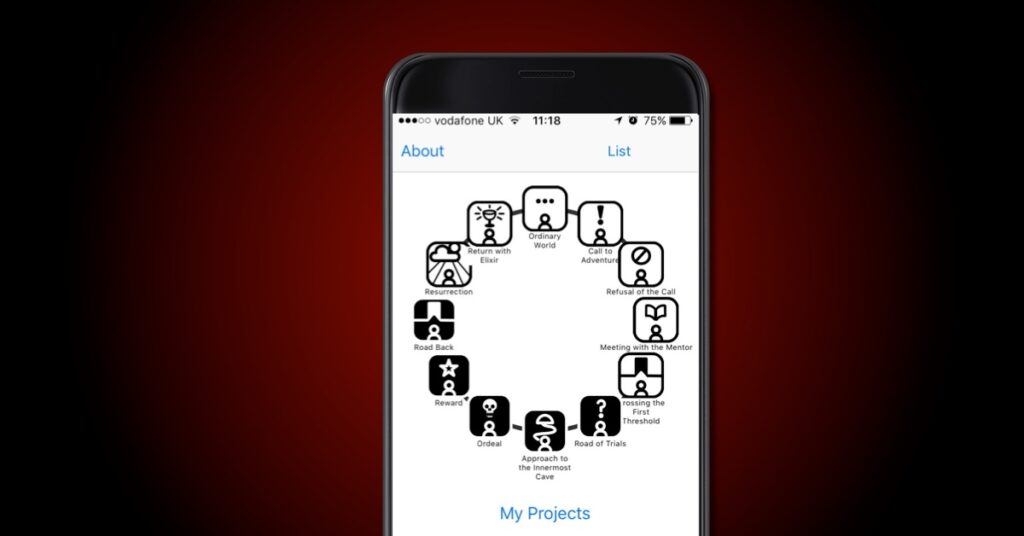
The Myth Structure for Writers App uses a writing tool known as the Hero’s Journey to structure your story. The Hero’s Journey recognises that our favourite stories follow a distinct pattern – and have been doing so for generations.
The pattern of the Hero’s Journey is so ingrained in our psyche, so tried and tested, that as audience members we feel cheated if the story we’re experiencing doesn’t follow it. So as a writer you should know it!
Want to know more? Read on to find out more about the Hero’s Journey “Myth Structure” and how it can shape and inspire your writing.
The Hero’s Journey
In 1949 the academic Joseph Campbell published a book called The Hero with a Thousand Faces, in which he outlined the common elements of thousands of stories he’d collected over time. He recognised the same patterns or events in many, many stories, usually in the same order. He proposed all stories have a basic underlying pattern that make them satisfying. When you become familiar with the pattern you begin to understand why – but more of that later.
Fast forward a few years and Christoper Vogler, author of The Writer’s Journey was working as a story development exec in Hollywood. He created a short, accessible summary of the various stages that Campbell had outlined and begun sharing it with his colleagues. It caught on pretty quickly. Here was a magic formula for making a satisfying story – and that’s exactly what Hollywood needed.
In fact, when you hear about the “Hollywood formula”, I guarantee that most times this is what is being referred to.
Christopher Vogler’s version of the story arc is simpler, (and I would say more visceral and less academic) than Campbell’s, so it’s his version that is available in the Myth Structure for Writers App and that I’ll cover off in more detail here.
The Hollywood Formula
The Hollywood Formula, known as the Myth Structure or the Hero’s Journey actually looks something like this:
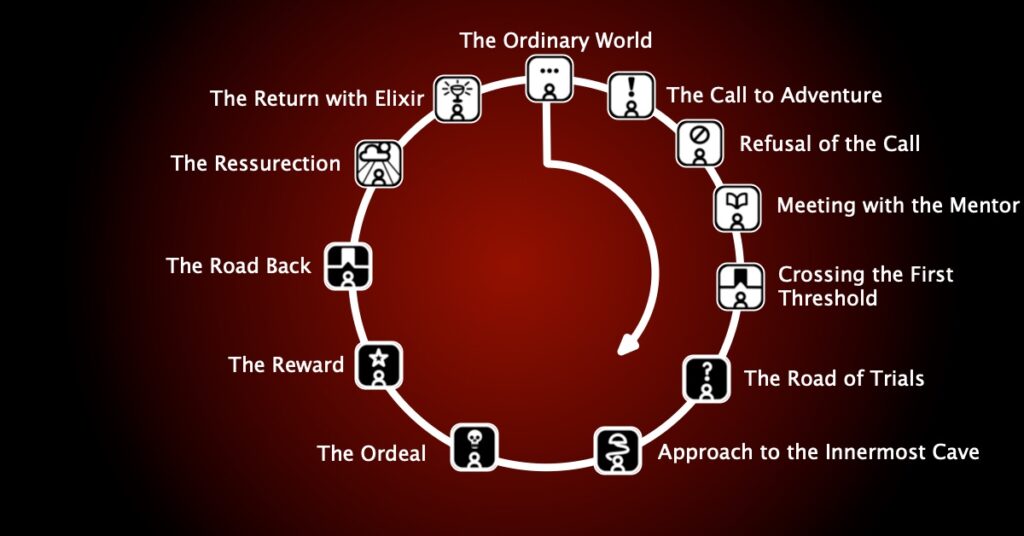
The story starts at the top and moves round in a clockwise direction. Each icon represents either a moment or a sequence in the story and has it’s own name.
What is amazing about the Myth Structure is that even without a story in your head, just stepping through the various elements of it, one begins to form, and for that reason its an incredibly powerful tool.
In his excellent book The Writer’s Journey, Christopher Vogler uses a movie often voted the best movie of all time – Star Wars – as an example. I think that’s a pretty good example so let’s stick with that. I’ll use the film’s structure to give examples as I step through each of the stages, but I’d encourage you to look for these same moments in pretty much any successful film or story.
Before we begin I want to make it clear that this is not the ONLY way to structure a story, but it is a very versatile and satisfying one. There is no shame in using this structure, but think of it as an empty shell to fill with your creative, brilliant interpretation of each stage.
If you would like a copy of the Myth Structure for Writers app, which has all of this information as well as a project space to create your own stories in this framework you can download it from the app store here.

 1.The Ordinary World
1.The Ordinary World 
To begin with, we see the Ordinary World of our main characters. This is where you establish where your story is set, introduce us to your main characters, and baldly state what the moral of your story is going to be.
Often the very first thing we see is a picture that sets the scene. It could be a cowboy riding out at sunrise, or an enormous spacecraft hunting down a smaller one against a starry background. It could be a Christmas department store or a playing field, lit by floodlights. Either way, present the world.
Then we probably want to see our characters doing their everyday thing in this world, Remember the ordinary world of the characters means what they find ordinary, not what you do. If you live in space in the middle of a war, then a battle among the stars is a common occurrence. CIA agents expect to be pulling their weapons and performing dawn raids. Killers are out there ‘a killin’ people. It’s whatever is Ordinary to them.
And then you should highlight that as well as this being everyday, it isn’t perfect. There are some things that need fixing or mending. Big things like stopping the war, small things like a teenager not connecting with their parents. This world is ordinary, but its not perfect.
Why is this bit important? Well, first you set the scene. As a writer you’re promising insight into a new world we don’t know that well. Then you need to lead us to some characters in that world, who are used to it, at home in it. Why? Because then we relate to them. That’s how we feel about the world. Also, if it’s a bit broken, we think, well I hope that gets better. So you have primed your audience for a story…
In Star Wars we meet the good guys – a rebel princess, and the bad guys – a black robed robot-man, and a bored kid who is a really good fighter pilot but has duties on a farm that harvests water. He’s bored and not living up to his potential. The rebels aren’t winning. Do we want to see those things fixed? Yes, we do.
In Se7en we see a fairly standard pairing – rookie cop and long-in-the-tooth investigator looking into a gruesome murder… It’s grim but it’s also everyday. Crimes of passion happen, people don’t think about killing each other.
 2. The Call To Adventure.
2. The Call To Adventure. 
Once we understand the routines of the Ordinary World, then it’s time to shake it up a little. Or preferably a lot. This is what we call the Call to Adventure. Something major happens to someone here.
Usually the Call to Adventure is delivered by an outside force that comes crashing into our Hero’s world. It brings a tremendous opportunity and a grave threat at the same time. It needs to promise great reward and great danger.
In Star Wars, the Call to Adventure for Luke comes when he uncovers the message from Princess Leia imploring him for help. In Se7en it’s when they discover that the murderer has sent them a message – Gluttony scrawled in grease on the wall. This is premediated murder.
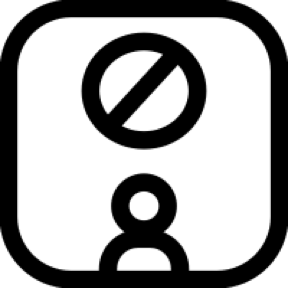 3. Refusal of the Call
3. Refusal of the Call 
The Hero, and the audience, should understand what the Call to Adventure means. It can’t be ignored. It won’t go away. It has to be dealt with. Luke can’t simply ignore this message he’s received.
But the Hero doesn’t immediately drop everything and rush off to sort things out. There is a moment of refusal. Either the Hero is too scared to go, or someone tells him: no way.
Luke’s uncle Owen tells him that Ben Kenobi’s just a crazy old man and orders him to wipe the droid’s memory, and refuses to let him go to the academy early…
In Se7en the Captain tells Somerset that Mills shouldn’t be on the case.
The point of this section is to make it clear that this quest is no mean feat. It’s going to be dangerous. The hero is going to have to risk something very important to them if they go after it. Do they really want to do that? This section serves a purpose to say: “This means something.” It’s the sign that says “abandon hope all ye who enter here…”
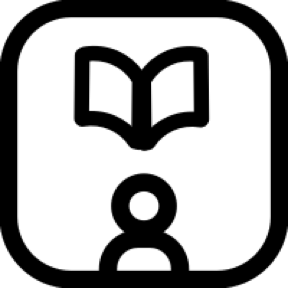 4. Meeting With the Mentor
4. Meeting With the Mentor 
The next phase is a kind of preparation. If you want to do something you’re not prepared for, you need to seek the advice of someone wise. In Luke’s case this is the crazy old wizard Old Ben (Obi Wan) Kenobi.
The Mentor is usually someone who has been through the battle before. They give the Hero some precious gifts that will help in the new world (a light saber) and some information they’d do well to remember (Darth Vader killed your father) In Se7en, they literally go to the library and learn about the Seven Deadly sins – which also expands the context beyond the rainy city streets to all the realms of heaven and hell.
This helps us deepen our interest in the adventure ahead. It is also a justifiable way of delivering a bit of structure and carefully delivered exposition.
 5. Crossing the First Threshold
5. Crossing the First Threshold 
The Hero usually still isn’t quite sure. The more they know about the new world, the less attractive it becomes. Yes they’re armed and ready, but do they want to go?
Eventually something pushes them through that door. A final force that they can’t resist any longer, the final piece of motivation: Luke’s family is slaughtered by imperial troopers looking for the droids.
So the hero and sometimes the Mentor have to go into a world they don’t know. It’s an exotic, upside-down world full of dangers and they usually land with a bump – getting into a bar fight or being shot at when they visit the killers apartment. They’re from another world and they’re not welcome. Things are done differently here.
 6. The Road of Trials
6. The Road of Trials 
In Christopher Vogler’s book The Writer’s Journey he calls this section Test, Allies and Enemies because this is where the Hero faces a series of tests (battling TIE-fighters, learning how to feel the force) while establishing friendships and making enemies. It does exactly what it says on the tin. This is the Hero learning by doing, rather than being told, and working out who is friend and who is foe. It’s a critical stage.
I call this the Road of Trials simply because I find it a bit more poetic. But the same things happen. The hero learns through trial and error as he moves towards….
 7. The Approach to the Innermost Cave
7. The Approach to the Innermost Cave 
This section occurs just before the first major battle with whatever is standing in the Hero’s way. The Hero is likely to go face to face (more or less) with his most powerful adversary – but before he does there’s a moment of preparation. This is the calm before the storm.
Here the heroes share personal stories about how they came to be here, what made them who they are, why this journey is important to them too. It’s a cementing of friendships, but also a build-up of anticipation for how the next phase is going to be difficult and scary. The heroes talk of their homes – we get a sense of how far away they are – and their philosophy (“Hokey religions and ancient weapons are no match for a good blaster […] kid”) . If they’re really dim they’ll show another character a picture of a loved one back home, and we the audience will go “well they’re going to die!”
 8. The Ordeal
8. The Ordeal 
This is the big battle – either the defining fight, or the courtroom “showdown” where the two opposing forces fight supposedly to the death. It is probably the first time the Hero meets their nemesis face-to-face. (Although Darth Vader and Luke do not meet in Star Wars, Darth Vader senses him, and is certainly aware of the impact of their presence).
The main quality of this episode is a huge clash of forces that will not be stopped by each other. Not everyone will survive, and the hero may not necessarily win, but will instead be left licking his or her wounds.
In Star Wars the whole sequence of rescuing Princess Leia is their Ordeal.
Either way, this is the moment that the audience has been building towards, the storm itself. Make sure it’s spectacular.
 9. The Reward
9. The Reward 
After having faced down the opponent, the Hero is usually granted some kind of reward. Either they uncover a bit of information or a tool that will help them defeat their enemy once and for all, or they are rewarded on a personal relationship level. This can be where the love interest tension is resolved, or a hard won friendship is cemented.
This part represents the euphoric feeling of having faced up to one’s fears. It’s always worth pushing yourself. But we should understand this is just a moment of shelter – the dark forces are not completely defeated yet… They have just been forced to withdraw.
 10. The Road Back
10. The Road Back 
The Hero and his team have made themselves known to their opponent as a visible and credible threat. Here, the dark forces that oppose them will gather pace and rather than being the pursuer, they are now the pursued – either physically or metaphorically.
This section will often involve a chase, a flight from the special world they have entered back to their home world. Suddenly the threat didn’t just exist over there… it’s starting to threaten their home world too. They have raised the stakes in taking the fight to the enemy and now the enemy is coming back to them…
The Hero is clear: there’s no way to defeat the menace by just standing up to it, he or she needs to be cunning as well – to come up with something clever to defeat their opponent.
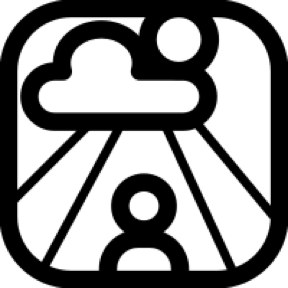 11. The Resurrection
11. The Resurrection 
As the dark forces close in there is usually a moment where the Hero hits rock bottom and faces the most tragic of losses. What this means will depend on the story but it can often mean that something happens that dashes all hope of winning. The Hero and the team reach a point where they cannot see a way to beat their opponent, and they’ve brought the problem back with them. Sometimes a key character dies. or the hero dies or a betrayal is revealed. Whatever occurs here, it represents a catastrophic failure for the hero.
The hero enters a period of mourning. Life is now worse than it was when they set out to answer the call. They are personally responsible for that situation too. This is their very darkest hour.
But, as the saying goes the darkest hour is just before dawn. At some point. the hero discovers, or realises, or is presented with some information that means there is a slim, slim chance….
This is where the title of this section comes from: The Resurrection. If the hero appears to die, this is where they will come back, or if the plan has failed this is where they will discover the one thread. What is resurrected here is Hope…
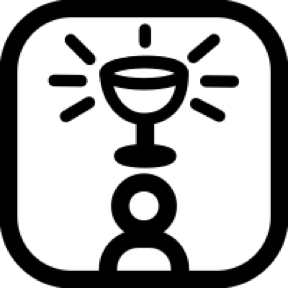 12. Return with Elixir
12. Return with Elixir 
This final section is the big showdown, where the slim plan is put into action, wobbles a little and then probably succeeds (it doesn’t always by the way – it depends whether you want to paint the world as a just and hopeful place or not).
Although in a way the name Return with Elixir inplies coming back home with the trophy, it is really best to think of this Elixir as being the Secret ingredient that can be used to defeat the enemy in the final battle. This is where the gift that the mentor gave the hero, and everything that they have learned – about their enemy, about friendships, about themselves come together in the winning formula to defeat their enemy.
The return with Elixir also implies that the hero becomes recognised as having that special gift – which they alone possess because they have been on the journey.
And that is the basic Hero’s Journey/Myth Structure formula. As you read it I hope you suddenly found recognisable moments from any genre of film popping up.
Why the Structure Works
There is much debate about why we tell stories, but the most common reason is to pass on wisdom. We recognise in every hero the person we’d like to be. Life plays out like a story: we know there are things we should tackle, life throws things at us. We need to get a bit of advice from an older mentor, learn some skills. We need to pick up friends along the way, and share our fears. We need to tackle our problems and accept that we can’t always defeat them first time round. We need to regroup and praise ourselves for trying. We discover that as we get better at things we face harder challenges – not everyone wants what we want. We also have to face complete defeat and disaster and its these experiences alone that teach us what we are capable of and gives us that most precious of things: hope that we might just achieve our goals.
And that is what the 12 stages of the Hero’s Journey show us, framed as a tale set in an unfamiliar world.
The Myth Structure App
in the Myth Structure for Writers App, which is available for iPhone, you will find
- Detailed descriptions of each stage
- Key moments to cover in each stage
- Approximate placement
- A Projects section for you to capture the Myth Structure of your own stories
- Export functionality to save your work into your writing software
Thanks for reading! Hope you have been inspired!